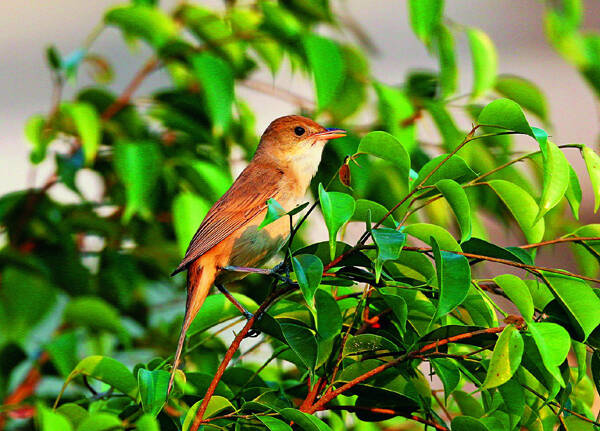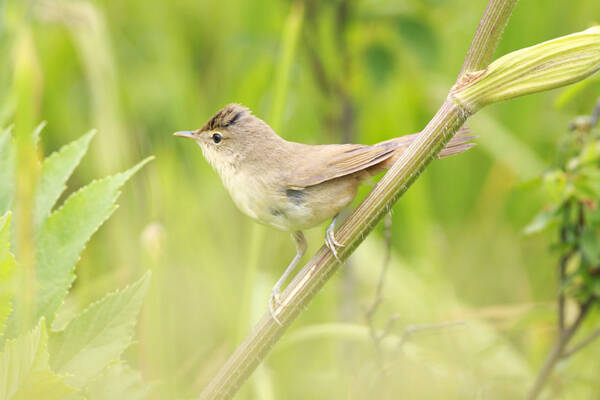Arundinax aedon
IUCN
LCBasic Information
Scientific classification
- name:Arundinax aedon
- Scientific Name:Arundinax aedon,Tree warbler, reed warbler, reed warbler, large-billed warbler
- Outline:Songbird
- Family:Passeriformes R.W.family R.W.genus
Vital signs
- length:17-32g
- Weight:166-200mm
- lifetime:
Feature
The mouth is wide, with a base width of more than 4 mm, and the whiskers are very developed with secondary whiskers.
Distribution and Habitat
It is found in Northeast China, North China, Central China, South China and the entire eastern part of China. It is distributed in Northeast Asia and Southeast Asia abroad.
Thick-billed reed warbler mainly inhabits low altitudes, low mountains and hills below 800 meters above sea level and plains at the foot of the mountain. It likes to move in small patches of jungle, shrubs and grass on both sides of the river valley, especially in the more open river valley shrubs and grass in the mountainous area. It is also often seen in sparse forests and shrubs with scattered tall trees, logging sites, jungles and grassland shrubs. But it does not like dense forests. During migration or wintering, it mainly inhabits forest edges, roadsides, shore shrubs, and grass, and is sometimes seen in trees near villages.
Appearance
The beak is short and thick, the front and around the eyes are pale yellowish white, there is no eyebrow pattern, the upper body is brown, the chin and throat are white, the rest of the lower body is yellowish, the tail is convex, the iris is brown, the upper beak is black, the lower beak is pink, and the feet are gray-brown.
Details
Thick-billed reed warbler is a bird of the family Albizia and genus Albizia. Like other reed warblers, it often moves and forages alone or in pairs in dense bushes and grasses. It is stealthy and moves quickly and agilely. During the breeding season, it often sings on high branches near the nest. Its voice is clear, melodious and pleasant to the ear. Sometimes it also imitates the calls of other birds.

The call is loud and full, starting with a crisp "tschok tschok" and unfolding into a pleasant whistle phrase plus imitation of other birds' calls; the call is a continuous "chak chak" and hoarse squeak.
The main food is insects such as Lepidoptera, Coleoptera, Orthoptera, and Hemiptera. The most common ones are Lepidoptera adults and larvae, as well as beetles, weevils, locusts, stink bugs, crickets, and ants. Occasionally, small invertebrates such as spiders and slugs are seen. 87.5% of the food is insects, mainly locusts, accounting for 50%; followed by Lepidoptera, ants, stink bugs, etc. In addition, some weeds and leaves are eaten.

The breeding season is from mid-May to early August. After migrating to the breeding grounds, male and female birds often chase each other in pairs in the bushes and gradually form pairs. Nests are mostly built in the bushes and grass on both sides of the river where the river is relatively flat and old trees are scattered. They especially like to build nests on shrubs such as honeysuckle, wild roses, spirea, hazelnuts, etc. where there are overgrown weeds and understory trees. Nests are mostly built by female birds, and the action is extremely concealed, and they often use materials on the spot near the nest. They often use grass stems and fibers to wrap around the branches of shrubs, and use the dense branches and leaves of shrubs to cover the nest, which is generally difficult to find. The nest is less than 1.2 meters from the ground. The nest is bowl-shaped, with a relatively sparse and simple structure. It is mainly composed of grass leaves, stems, plant fibers and roots, and is padded with soft grass roots and grass stems. The size of the nest is 10-12 cm in outer diameter, 7-8 cm in inner diameter, 7.5-8.4 cm in height, and 6-6.5 cm in depth. Each nest takes about 6 days to build.

Generally, eggs are laid on the same day after the nest is built, but sometimes they are laid a few days after the nest is built. One egg is laid per day, and 5-6 eggs are laid per nest. The eggs are light pink or white rose, with purple-brown spots and patterns of varying sizes and shapes, especially at the blunt end. The size of the eggs is (21-23) mm × (16-18) mm. After all the eggs are laid, they begin to incubate. The incubation is mainly undertaken by the female bird. The incubation period is 11-14 days. The brooding period is 13-15 days.
Listed in the "Red List of Threatened Species of the World Conservation Union" (IUCN) 2016 ver3.1 - Least Concern (LC).







